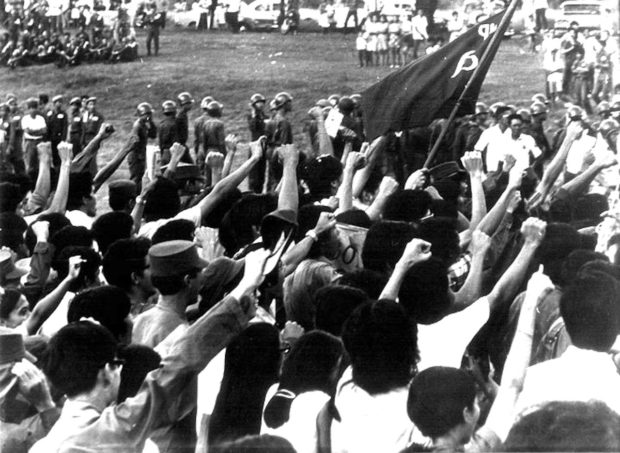
A student protest during the First Quarter Storm, 1970.
Fifty years ago, young Filipinos rose up against a corrupt president who went on to become a brutal dictator.
This month marks the 50th anniversary of the First Quarter Storm, known simply as the FQS.
It’s a chapter in Philippine history many Filipinos have probably forgotten. But it’s an important event, a part of our past that offers many important lessons for today’s young Filipinos.
The First Quarter Storm refers to the first three months of 1970 when young Filipinos staged mass demonstrations against Ferdinand Marcos, protests that were at times suppressed with violence.
Marcos was then on his second term as president, after winning in what was then known as the dirtiest election in Philippine history. Marcos became the first president to actually win a second term, and he did it with widespread fraud and corruption.
But just six months into his second term, young Filipinos had had enough.
On January 26, 1970, thousands joined a big demonstration against Marcos’s state of the nation speech. The mass action was dispersed violently by security forces. But that didn’t discourage the youth from launching another mass action. Four days later, on January 30, they staged another, bigger demonstration that led to another violent dispersal.
As my friend, the journalist and poet Pete Lacaba, wrote in “Days of Disquiet, Nights of Rage,” his classic account of the FQS, “January 26 seemed explosive enough —but it was a whimper compared with the horrendous bang of January 30. The papers called January 26 a riot. January 30 was something else. ‘This is no longer a riot,’ said a police officer. ‘This is an insurrection.’”
The FQS was a huge event, although it’s striking how it has meant different things to different people. In some cases, its significance has evolved through the years.
It is still seen as a youth movement aimed at an abusive leader who clearly hoped to stay in power forever.
One of the most famous figures of the FQS was the Ateneo student leader Edgar Jopson who dared to ask Marcos to promise that he would not seek a third term.
Marcos’s response underscored his arrogance. He snapped at the young Jopson, derisively calling him a “mere son of a grocer.”
I was six years old when the FQS happened. My parents were critical of Marcos, but they weren’t crazy about the daily demonstrations, particularly those that ended in violent dispersals.
And they weren’t crazy that my sisters, two of their eldest daughters, became drawn to the student activists. The FQS subsequently led to more ironfisted tactics from Marcos and to martial law and the rise of dictatorship.
It was at that point that the FQS had a bigger impact on me and my family, and the families of many other Filipinos. My sisters were among the young Filipinos who joined the underground fight against the dictatorship.
For more than a decade, the FQS was seen as the youth rebellion that eventually led to the fall of a tyrant.
My own view of the FQS evolved after Marcos’s fall in 1986. Yes, it was a heroic chapter in Philippine history, when young Filipinos like Edgar Jopson and thousands many others reacted to corruption and political abuse by taking to the streets, by coming together to fight tyranny.
The fight against Marcos led to the deaths of many young martyrs: Edjop, Eman Lacaba, Lorena Barros, Bobby de la Paz, Macliing Dulag, Juan Escandor.
But it was while writing “UG, An Underground Tale,” a biography of Edjop, that I came across the untold tales and secrets about the FQS and the events that followed.
The most stunning was the revelation that it was the UG left, not Marcos, who was responsible for the 1971 bombing of the Liberal Party rally at Plaza Miranda. For decades, Marcos was blamed for the crime, which he in fact also used as an excuse to eventually declare martial law.
I still consider the FQS as an important chapter in Philippine history, an event that should be remembered and studied, and from which important lessons can be drawn.
One is that we must never romanticize movements and their leaders, including those who present themselves as champions of the people, as the nation’s saviors simply because they come from a prominent family, or because they claim to be sent by a god or have history on their side.
The other lesson is more important and relevant as the nation reels from another regime led by a thug: trust and listen to young people. They may be inexperienced and impulsive, but when in the face of corruption, tyranny and abuse, they will fight back.
Visit the Kuwento page on Facebook.

